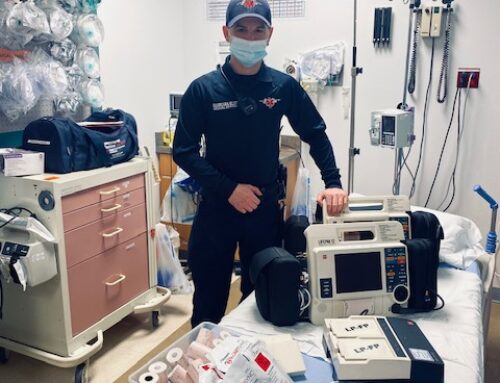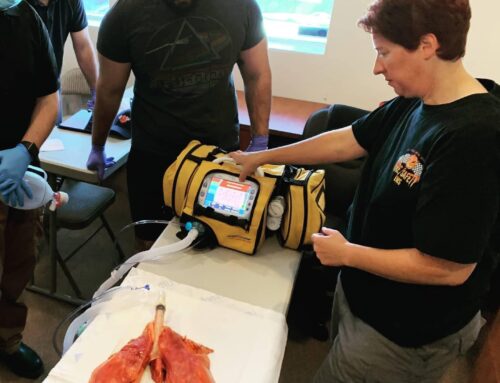On Site Antigen Testing
By Samuel Scheller, MBA, Paramedic
January 3, 2020
The 2020, SARS-CoV-2 virus, also referred to as COVID-19 or Corona Virus has taken over everyone’s lives, with many people out of work due to non-essential services being shut down. As the world begins to return to the new normal, rapid COVID testing is becoming commonplace in many areas including movie production, travel, and return to work practices following a possible infection. In this article, we are going to look at these new rapid COVID tests and their effectiveness in determining whether someone is COVID positive.
Types of Test
There are three main types of tests being used to determine whether someone is infected or has been infected with COVID-19:
- PCR (polymerase chain reaction) nasal swab – This test uses a swab that goes up the nose and the sample is sent to the lab to be analyzed. The lab looks for traces of the genetic material, or nucleic acids, left by the corona virus (DeMarco, 2020). The issue with this type of test is that it must be sent to the lab, which can take up to 48 hours or longer depending on the lab and the amount of tests that need to be performed. This test is considered a more accurate predictor of current infection of COVID-19 compared to the antibody tests and antigen tests dicussed below.
- Antibody tests – This test uses a blood sample to see if the person has been previously exposed to COVID-19. Antibody tests do not determine active infections! Further, there is a high chance that someone has had COVID-19 and tests negative because they did not make the antibodies for which the individual test is looking for or there is a high chance of a false positive because COVID-19 is part of the Corona Virus family and these tests look simply for antibodies made from this type of family of virus; not specifically COVID-19 (DeMarco, 2020). Remember, if you test positive on an antibody test you are not actively infected, rather your body has been exposed to a virus from the Corona Virus family.
- Antigen test – This is the “rapid test” and will be the focus of this article. Basically, the antigen test looks for the viral proteins that tell the body to make antibodies (DeMarco, 2020).
What is an Antigen?
The word antigen is short for “antibody generator;” meaning antigens tell the body to create antibodies. Antigens are typically proteins or sugars that are found on the surface of cells that allow the body to determine self versus not-self. This recognition of self vs. not-self is important in starting the body’s immune response towards an invading pathogen. When an invader (such as the COVID-19) enters the body, an immune response starts by the body recognizing, through antigens, that the virus is not wanted in the body. This kicks off an immune response from the body, but it all starts with the body recognizing the antigens of the virus as not being part of the body (DeMarco, 2020, p. 713).
Antigen vs. Antibody
As mentioned above, an antigen is part of a cell that allows the body to determine self versus not-self (Pollak, 2018, p. 713). Antibodies are proteins the body develops in response to antigens from outside pathogens to provide immunity from future infections. In other words, antibodies are what the body remembers after being infected to prevent the same infection from occurring. You can almost think of it in the sense that antigens are what start the immune response and antibodies are what end the immune response once the body has learned what the invading pathogen is. It is important to note that antibodies are not immediately produced; in some cases it can take almost three weeks for the body to create antibodies (Centers for Disease Control and Prevention, 2020). This is one of the reasons why antibody tests are not a reliable indicator of active infection of any disease, including COVID-19.
How does onsite Antigen testing work?
Antigen tests are considered rapid tests (meaning results in 15 minutes or less) that can be performed at the Point of Care (POC), outside of a traditional laboratory (Access Bio, Inc., 2020, p. 1). A person’s nasopharynx is swabbed and the swab is placed into a specimen vial. The solution in the vial is mixed around and the solution is placed on a device that determines the presence of SARS-CoV-2 antigens. Antigen testing is 100% specific for the SARS-CoV-2 antigen; which means that the test is only looking for antigens associated with the SARS-CoV-2 virus and no other types of viruses or disease (CareStart). This is an attractive testing option for many return to work programs to determine if a worker is infected with COVID-19 because of the quick turnaround time of results. In all cases results take as little as 15 minutes!
Limitations of Antigen Tests
It is important to note that antigen tests come with their limitations. According to the manufacturer of the CareStart COVID-19 Antigen test, “a negative result does not rule out COVID-19 and should not be used as the sole basis for treatment or patient management decisions, including infection control decisions. Antigen tests are known to be less sensitive than molecular tests that detect viral nucleic acids” (Access Bio, Inc., 2020, p. 1). In other words, someone who is positive for COVID-19 can still have negative results on a COVID-19 antigen test. The manufacturer recommends a PCR test to confirm the presence of an active COVID-19 infection because “specimens collected after day 5 of illness may be more likely negative compared to a RT-PCR” (Access Bio, Inc., 2020, p. 1).
Why must the swab be shoved so far up my nose?
Another limitation of antigen testing is obtaining a really good sample. Testing for COVID-19 can be uncomfortable for some people. Depending on the test, a swab is placed into the nasopharynx, which is located behind the nose and above the throat. This area of the body is rarely touched by outside objects, which makes it really uncofortable! However, it is very important to place the swab in this area of the body because COVID-19 starts replicating in the upper respiratory tract (DeMarco, 2020); making the nasopharynx the best place to get a really good sample!

1 This picture shows how far up the nose a nasopharyngeal nasal swab is placed (CareStart, 2020).
Work Safety with Antigen Testing
Given the limitations of antigen testing, can they be used for work safety programs? By themselves, no. In other words, workplaces who wish to use an antigen test for work safety or return to work programs should not use the antigen test as the sole test to allow workers to return to work. The workplace should have a combination of a daily questionnaire about possible symptoms, temperature checking, and antigen testing for its workplace safety/return to work programs. Employees who are feeling sick with a body temperature greater than 100°F and test negative on a rapid antigen test can still be infected with another pathogen other than the SARS-CoV-2 virus, such as Influenza (aka. the flu). These other pathogens can be spread about the workplace and should be of equal concern to supervisors and managers. By not allowing any sick employee to come to work, regardless of a SARS-CoV-2 test result, ensures work safety from a variety of common illnesses. In addition, workplaces should be following strict cleaning guidelines to prevent the spread of communicable disease.
What has been my experience with performing the rapid tests?
This next section is completely anecdotal and should not be taken as any kind of scientific evidence. As of January 3, 2020, my team and I have performed over 400 rapid tests to the public, our staff, friends of the company, and various production crews. Each person who is testing using an antigen test is assessed for symptoms including:
- Fever
- Cough
- Congestion
- Lack of taste
- Muscle weakness
100% of those people who report losing their taste has a positive antigen test. Those who report flu like symptoms are tested and the results are mixed. About half test positive for the antigens whereas the other half do not. For our production teams, we have yet to test a production where a worker came to work positive. In our last production we tested over 250 workers in three days and all the tests came back negative. I attribute this to the pre work questionnaires, temperature screening, and encouraging those who are feeling sick to stay home and not come to work. In addition, the manufacturer of one of the tests states that this test is most valid “within the first five days of the onset of symptoms” (CareStart). In other words, if an individual is not displaying any symptoms as mentioned above, they can be an asymptotic carrier of the SARS-CoV-2 virus and will probably test negative on an antigen test. These individuals will need to be checked using a PCR test to assess for nucleic acids. This is why a comprehensive screening process of symptom screening, temperature checking, and antigen testing is important for return-to-work procedures.
About COVID Compliance Solutions
COVID Compliance Solutions is a subsidiary of Guardian Elite Medical Services, LLC. Since the beginning of the pandemic, we have been leading the way in return-to-work programs including temperature screening, on site COVID Compliance Officers, and performing COVID tests using PCR nasal swabs and now rapid testing. To learn more about our services, please contact us at 702-420-2332 or covidcompliance@gemslv.com.
Sources
Access Bio, Inc. (2020, October 8). Life-Assist. Retrieved January 2021, from Fact Sheet for Healthcare Providers: https://www.life-assist.com/Content/Docs/CareStart_hcp_factsheet.pdf
CareStart. (2020, October 07). Food and Drug Administration. Retrieved October 2020, from CareStart COVID-19 Antigen Package Insert: https://www.fda.gov/media/142919/download
CareStart. (n.d.). Life-Assist. Retrieved January 2021, from Care Start COVID-19 Antigen A Rapid POC Test: https://www.life-assist.com/Content/Docs/Carestart_Covid-19Test_overview.pdf
Centers for Disease Control and Prevention. (2020, October 29). Centers for Disease Control and Prevention. Retrieved January 2021, from Test for Past Infection: https://www.cdc.gov/coronavirus/2019-ncov/testing/serology-overview.html
DeMarco, C. (2020, May 21). 11 Things To Know About COVID Testing. Retrieved from The University of Texas MD Anderson Cancer Center: https://www.mdanderson.org/cancerwise/is-covid-19-coronavirus-testing-accurate-and-9-more-things-to-know-about-covid-19-nasal-swab-testing.h00-159381945.html
Pollak, A. (2018). Critical Care Transport: Second Edition. Burlington, MA: Jones and Bartlett Learning.

2 A review of the process to collect the sample and process the results of the CareStart Point of Care COVID-19 Antigen Test.



